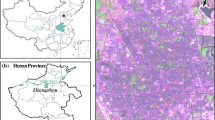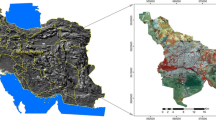Abstract
Tehran, the capital of Iran, is the most densely populated city in the country that has been experiencing extensive population growth and urban expansion in the last decades. The land use/cover (LULC) patterns have noticeably been changed to impervious surfaces that led to the changes in the thermal condition and forming heat islands in Tehran. In this study, the relationship of LULC patterns with land surface temperature (LST) was investigated using landscape metrics in the city of Tehran. For this aim, the LULC map of the year 2012 was derived from Landsat 7 images. The spectral mixture analysis (SMA) and proximity likelihood algorithm were used to classify the LULC map. Then, the LST zoning map was produced from the thermal sensor band and was classified based on standard deviation and quartile deviation methods. Finally, the landscape metrics applied to analyze the relationship between the LULC patterns and LST zones. The results showed that the LST had a positive correlation with the impervious surface fraction but negatively correlated with the green vegetation fraction. The result also indicated that the temperature decreased with an increase in landscape percent and mean patch size of green spaces. The findings of this study could be useful for urban plans, land use planning, and sustainable development goals programs.









Similar content being viewed by others
References
Alavipanah SK (2006) Thermal remote sensing and application in earth sciences. Tehran University Press
Artis DA, Carnahan WH (1982) Survey of emissivity variability in thermography of urban areas. Remote Sens Environ 12:13–329
Asgarian A, Amiri BJ, Sakieh Y (2015) Assessing effect of green cover spatial patterns on urban land surface temperature using landscape metrics approach. Urban Ecosyst 18:209–222
Fichera CR, Modica G, Pollino M (2012) Land Cover classification and change-detection analysis using multi-temporal remote sensed imagery and landscape metrics. Eur J Remote Sens 45:1–18
Gergel SE, Turner MG (2017) Learning landscape ecology: a practical guide to concepts and techniques. Springer-Verlag, New York
Ghobadi Y, Pradhan B, Shafri HZM, Kabiri K (2015) Assessment of spatial relationship between land surface temperature and landuse/cover retrieval from multi-temporal remote sensing data in South Karkheh Sub-basin, Iran. Arab J Geosci 8:525–537
Guo G, Wu Z, Xiao R, Chen Y, Liu X, Zhang X (2015) Impacts of urban biophysical composition on land surface temperature in urban heat island clusters. Landsc Urban Plan 135:1–10
Han G, Xu J (2013) Land surface phenology and land surface temperature changes along an urban–rural gradient in Yangtze River Delta, China. Environ Manag 52:234–249
Karimi H, Jafarnezhad J, Khaledi J, Ahmadi P (2018) Monitoring and prediction of land use/land cover changes using CA-Markov model: a case study of Ravansar County in Iran. Arab J Geosci 11:592–599
Karimi H, Jafarnezhad J, Kakhani A (2020) Landsat time-series for land use change detection using support vector machine: case study of Javanrud District, Iran. International Conference on Computer Science and Software Engineering (CSASE). Duhok, Iraq, pp 128–131
Kikon N, Singh P, Singh SK, Vyas A (2016) Assessment of urban heat islands (UHI) of Noida City, India using multi-temporal satellite data. Sustain Cities Soc 22:19–28
Kourosh Niya A, Huang J, Karimi H, Keshtkar H, Naimi B (2019) Use of intensity analysis to characterize land use/cover change in the biggest Island of Persian Gulf, Qeshm Island, Iran. Sustain Sci 11:4396–4406
Kourosh Niya A, Huang J, Kazemzadeh-Zow A, Karimi H, Keshtkar HR, Naimi B (2020) Comparison of three hybrid models to simulate land use changes: a case study in Qeshm Island, Iran. Environ Monit Assess 192:302–311
Kumar M, Denis DM, Kumar S, Szabó S, Suryavanshi S (2018) Landscape metrics for assessment of land cover change and fragmentation of a heterogeneous watershed. Remote Sens Appl Soc Environ 10:224–233
Lamine S, Petropoulos GP, Singh SK, Szabó S, Bachari NEI, Srivastava PK, Suman S (2017) Quantifying land use/land cover spatio-temporal landscape pattern dynamics from Hyperion using SVMs classifier and FRAGSTATS ®. Geocarto Int 33:862–878
Leitao AB, Ahern J (2002) Applying landscape ecological concepts and metrics in sustainability. Landsc Urban Plan 59:65–93
Li X, Zhou W, Ouyang Z (2013) Relationship between land surface temperature and spatial pattern of greenspace: what are the effects of spatial resolution? Landsc Urban Plan 114:1–8
Liu H, Weng Q (2009) Scaling effect on the relationship between landscape pattern and land surface temperature: a case study of Indianapolis, United States. Photogramm Eng Rem S 75:291–304
Liu L, Zhang Y (2011) Urban heat island analysis using the Landsat TM data and ASTER data: A case study in Hong Kong. Remote Sens-Basel 3:1535–1552
Liu Y, Peng J, Wang Y (2018) The efficiency of landscape metrics characterizing urban land surface temperature. Landsc Urban Plan 180:36–53
Liu S, Yu Q, Wei C (2019) Spatial-temporal dynamic analysis of land use and landscape pattern in Guangzhou, China: exploring the driving forces from an urban sustainability perspective. Sustain Sci 11:6675–6695
Lo CP, Quattrochi DA (2003) Land-use and land-cover change, urban heat island phenomenon, and health implications: a remote sensing approach. Photogramm Eng Rem S 69:1053–1063
Lu D, Weng Q (2006) Use of impervious surface in urban land-use classification. Remote Sens Environ 102(1–2):146–160
Madanian M, Soffianian A, Soltani Koupai S, Pourmanafi S, Momeni M (2018) Analyzing the effects of urban expansion on land surface temperature patterns by landscape metrics: a case study of Isfahan city, Iran. Environ Monit Assess 190:189–202
Mandelbrot BB (1983) The fractal geometry of nature. WH Freeman, San Francisco, California, CA
McGarigal K (2015) Fragstats help. Amherst: Department of Environmental Conservation University of Massachusetts
McGarigal K, Marks BJ (1995) FRAGSTATS: spatial pattern analysis program for quantifying landscape structure, General Technical Report PNW-GTR-351, USDA Forest Service, Pacific Northwest Research Station, Portland
Meyer WB, Turner BL (1996) Land-use/land-cover change: challenges for geographers. Geoj 39:237–240
Muhammed A, Karimi H, Gharab B, Dilkhaz D & Mirzaei K (2020) Assessing the quality of the environment in Duhok province, Kurdistan Region of Iraq. J Civ Eng of Front 1:20–24. https://doi.org/10.38094/jocef119
Mustafa YT (2020a) Multi-temporal satellite data for land use/cover (LULC) change detection in Zakho, Kurdistan Region-Iraq. In: Al-Quraishi A, Negm A (eds) Environmental Remote Sensing and GIS in Iraq. Springer Water. Springer, Cham
Mustafa YT (2020b) Spatiotemporal analysis of vegetation cover in Kurdistan Region-Iraq using MODIS image data. J Appl Sci Te Trends 1:1–7
Ridd MK (1995) Exploring a VIS (vegetation–impervious surface–soil) model for urban ecosystem analysis through remote sensing: comparative anatomy for cities. Int J Remote Sens 16:2165–2185
Ritchie H, Roser M (2013) Land use. Published online at OurWorldInData.org. Retrieved from: 'https://ourworldindata.org/land-use' [Online Resource]
Sanderson EW, Jaiteh M, Levy MA, Redford KH, Wannebo AV, Woolmer G (2002) The human footprint and the last of the wild: the human footprint is a global map of human influence on the land surface, which suggests that human beings are stewards of nature, whether we like it or not. Biosci 52:891–904
Sasanpour F, ZeaieanP, Bahadori M (2013) Investigating the relationship between land use and land cover and thermal islands in Tehran. Geog 11(39):256–270 (in Persian).
Shakiba AR, Ziaeyan P, Ashorlo D, Namdari S (2009) Analysis of land use relationship and land cover and thermal islands of Tehran using ETM + data. IJRSGIS 1:39–56 ( in Persian)
Singh SK, Srivastava P, Szabó S, Petropoulos G, Gupta M, Islam T (2017) Landscape transform and spatial metrics for mapping spatiotemporal land cover dynamics using Earth Observation data-sets. Geocarto Int 32:113–127
Small C (2001) Estimation of urban vegetation abundance by spectral mixture analysis. Int JRemote Sens 22:1305–1334
Smith RM (1986) Comparing traditional methods for selecting class intervals on choropleth maps. Prof Geogr 38:62–67
Sobrino JA, Oltra-Carrió R, Sòria G, Jiménez- Muñoz JC, Franch B, Hidalgo V, Mattar C, Julien Y, Cuenca J, Romaguera M (2013) Evaluation of the surface urban heat island effect in the city of sensing. In J Remote Sens 34(9–10):3177–3192
Sousa D, Small C (2017) Global cross-calibration of Landsat spectral mixture models. Remote Sens Environ 192:139–149
Statistical Center of Iran (2016) https://www.amar.org.ir/ (in Persian)
Sue YF, Foody GM, Cheng KS (2012) Spatial non-stationarity in the relationships between land cover and surface temperature in an urban heat island and its impacts on thermally sensitive populations. Landsc Urban Plan 107:172–180
Tong X, Liu T, Singh VP, Duan L, Long D (2016) Development of in situ experiments for evaluation of anisotropic reflectance effect on spectral mixture analysis for vegetation cover. IEEE Geosci Remote S 13:636–640
Turner MG (1990) Spatial and temporal analysis of landscape patterns. Landsc Ecol 4:21–30
Valor, E., & Caselles, V (1996) Mapping land surface emissivity from NDVI: application to European, African and South American areas. Remote Sens Environ 57:167–184
Wang H, Zhang Y, Tsou JY, Li Y (2017) Surface urban heat island analysis of Shanghai (China) based on the change of land use and land cover. Sustain Sci 9:1538–1561
Wang Y-C, Hu BKH, Myint SW, Feng C-C, Chow WTL, Passy PF (2018) Patterns of land change and their potential impacts on land surface temperature change in Yangon, Myanmar. Sci Total Environ 643:738–750
Weng Q (2009) Thermal infrared remote sensing for urban climate and environmental studies: methods, applications, and trends. ISPRS J Photogramm 64:335–344
Weng Q, Lu D, Schubring J (2004) Estimation of land surface temperature- vegetation abundance relationship for urban heat island studies. Remote Sens Environ 89:467–483
Weng Q, Liu H, Lu D (2007) Assessing the effects of land use and land cover patterns on thermal conditions using landscape metrics in the city of Indianapolis, United States. Urban Ecosyst 10:203–219
Wu C, Murray AT (2003) Estimating impervious surface distribution by spectral mixture analysis. Remote Sens Environ 84:493–505
Wubie M, Assen M, Nicolau MD (2016) Patterns, causes and consequences of land use/cover dynamics in the Gemara watershed of Lake Tana basin, Northwestern Ethiopia. Environ Syst Res 5:8–20
Xie M, Wang Y, Chang Q, Fu M, Ye M (2013) Assessment of landscape patterns affecting the land surface temperature in different biophysical gradients in Shenzhen, China. Urban Ecosyst 16:871–886
Yusuf YA, Pradhan B, Idrees MO (2014) Spatio-temporal assessment of urban heat island effects in Kuala Lumpur metropolitan city using Landsat images. J Indian Soc Remote Sens 42:829–837
Zhou W, Qian Y, Li X, Li W, Han L (2014) Relationships between land cover and the surface urban heat island: seasonal variability and effects of spatial and thematic resolution of land cover data on predicting land surface temperatures. Landsc Ecol 29:153–167
Author information
Authors and Affiliations
Corresponding author
Ethics declarations
Conflict of interest
The authors declare no competing interests.
Additional information
Responsible Editor: Biswajeet Pradhan
Rights and permissions
About this article
Cite this article
Effati, F., Karimi, H. & Yavari, A. Investigating effects of land use and land cover patterns on land surface temperature using landscape metrics in the city of Tehran, Iran. Arab J Geosci 14, 1240 (2021). https://doi.org/10.1007/s12517-021-07433-4
Received:
Accepted:
Published:
DOI: https://doi.org/10.1007/s12517-021-07433-4




